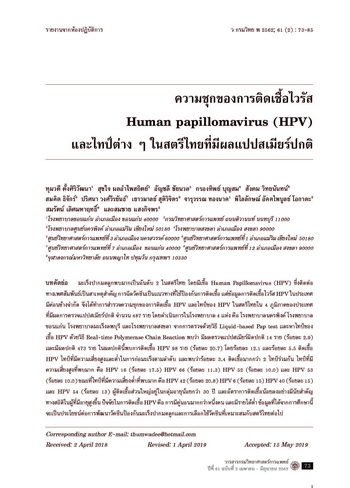ความชุกของการติดเชื้อไวรัส Human papillomavirus (HPV) และไทป์ต่าง ๆ ในสตรีไทยที่มีผลแปปสเมียร์ปกติ
คำสำคัญ:
human papillomavirus, prevalence, HPV typeบทคัดย่อ
มะเร็งปากมดลูกพบมากเป็นอันดับ 2 ในสตรีไทย โดยมีเชื้อ Human Papillomavirus (HPV) ซึ่งติดต่อทางเพศสัมพันธ์เป็นสาเหตุสำคัญ การฉีดวัคซีนเป็นแนวทางที่ใช้ป้องกันการติดเชื้อ แต่ข้อมูลการติดเชื้อไวรัส HPV ในประเทศมีค่อนข้างจำกัด จึงได้ทำการสำรวจความชุกของการติดเชื้อ HPV และไทป์ของ HPV ในสตรีไทยใน 4 ภูมิภาคของประเทศที่มีผลการตรวจแปปสเมียร์ปกติ จำนวน 487 ราย โดยดำเนินการในโรงพยาบาล 4 แห่ง คือ โรงพยาบาลนครพิงค์ โรงพยาบาลขอนแก่น โรงพยาบาลมะเร็งลพบุรี และโรงพยาบาลสงขลา จากการตรวจด้วยวิธี Liquid-based Pap test และหาไทป์ของเชื้อ HPV ด้วยวิธี Real-time Polymerase Chain Reaction พบว่า มีผลตรวจแปปสเมียร์ผิดปกติ 14 ราย (ร้อยละ 2.9) และมีผลปกติ 473 ราย ในผลปกตินี้พบการติดเชื้อ HPV 98 ราย (ร้อยละ 20.7) โดยร้อยละ 12.1 และร้อยละ 5.5 ติดเชื้อ HPV ไทป์ที่มีความเสี่ยงสูงและต่ำในการก่อมะเร็งตามลำดับ และพบว่าร้อยละ 3.4 ติดเชื้อมากกว่า 2 ไทป์ร่วมกัน ไทป์ที่มีความเสี่ยงสูงที่พบมาก คือ HPV 16 (ร้อยละ 17.5) HPV 66 (ร้อยละ 11.3) HPV 52 (ร้อยละ 10.0) และ HPV 53 (ร้อยละ 10.0) ขณะที่ไทป์ที่มีความเสี่ยงต่ำที่พบมาก คือ HPV 42 (ร้อยละ 20.8) HPV 6 (ร้อยละ 15) HPV 40 (ร้อยละ 15) และ HPV 54 (ร้อยละ 13) ผู้ติดเชื้อส่วนใหญ่อยู่ในกลุ่มอายุน้อยกว่า 30 ปี และอัตราการติดเชื้อน้อยลงอย่างมีนัยสำคัญทางสถิติในผู้ที่มีอายุสูงขึ้น ปัจจัยในการติดเชื้อ HPV คือ การมีคู่นอนมากกว่าหนึ่งคน และมีรายได้ต่ำ ข้อมูลที่ได้จากการศึกษานี้ จะเป็นประโยชน์ต่อการพัฒนาวัคซีนป้องกันมะเร็งปากมดลูกและการเลือกใช้วัคซีนที่เหมาะสมกับสตรีไทยต่อไป
เอกสารอ้างอิง
National Cancer Institute, Ministry of Public Health (Thailand). Cancer in Thailand Vol. IX, 2013-2015. [Online]. Available from: URL: https://www.nci.go.th/th/File_download/Nci%20Cancer%20Registry/Cancer%20in%20Thailand%20IX_(Unpublished%20Edition)03.pdf.
Bruni L, Barrionuevo-Rosas L, Albero G, Serrano B, Mena M, Gomez D, et al. ICO/IARC In-formation Center on HPV and Cancer. Human papillomavirus and related diseases in the world. Summary report 27 July 2017. [Online]. Available from: URL: https://hpvcentre.net/statistics/reports/XWX.pdf.
Baseman JG, Koutsky LA. The epidemiology of human papillomavirus infections. J Clin virol 2005; 32(Suppl 1): S16-S24.
Wentzensen N, Schiffman M, Dunn ST, Zuna RE, Walker J, Allen RA, et al. Grading the se-verity of cervical neoplasia based on combined histopathology, cytopathology, and HPV geno-type distribution among 1700 women referred to colposcopy in Oklahoma. Int J Cancer 2009; 124(4): 964-9.
Dunne EF, Unger ER, Sternberg M, McQuillan G, Swan DC, Patel SS, et al. Prevalence of HPV infection among females in the United States. JAMA 2007; 297(8): 813-9.
Bosch FX, de Sanjose S. Chapter 1: Human papillomavirus and cervical cancer-burden and as-sessment of; causality. J Natl Cancer Inst Monogr 2003; (31): 3-13.
Braaten KP, Laufer MR. Human papillomavirus (HPV), HPV-related disease, and the HPV vaccine. Rev Obstet Gynecol 2008; 1(1): 2-10.
Signorelli C, Odone A, Ciorba V, Cella P, Audicio RA, Lombardi A, et al. Human papilloma-virus 9-valent vaccine for cancer prevention: a systematic review of the available evidence. Ep-idemiol Infect 2017; 145(10): 1962-82.
Clifford GM, Gallus S, Herrero R, Munoz N, Snijders PJ, Vaccarella S, et al. Worldwide distribution of human papillomavirus types in cytologically normal women in the international agency for research on cancer HPV prevalence surveys: a pooled analysis. Lancet 2005; 366: 991-8.
de Sanjose S, Diaz M, Castellsague X, Clifford G, Bruni L, Munoz N, et al. Worldwide preva-lence and genotype distribution of cervical human papillomavirus DNA in women with normal cytology: a meta-analysis. Lancet Infect Dis 2007; 7(7): 453-9.
Bruni L, Diaz M, Castellsague X, Ferrer E, Bosch FX, de Sanjose S. Cervical human papillomavirus prevalence in 5 continents: meta-analysis of 1 million women with normal cytological findings. J Infect Dis 2010; 202(12): 1789-99.
Allan B, Marais DJ, Hoffman M, Shapiro S, Williamson AL. Cervical human papillomavirus (HPV) infection in South African women: implications for HPV screening and vaccine strate-gies. J Clin Microbiol 2008; 46(2): 740-2.
Pista A, de Oleveira CF, Cunha MJ, Paixao MT, Real O. Prevalence of human papillomavirus infection in women in Portugal: the CLEOPATRE Portugal study. Int J Gynecol Cancer 2011; 21(6): 1150-8.
Zhao FH, Zhu FC, Chen W, Li J, Hu YM, Hong Y, et al. Baseline prevalence and type distribution of human papillomavirus in healthy Chinese women aged 18-25 years enrolled in a clinical trial. Int J Cancer 2014; 135: 2604-11.
Kantathavorn N, Mahidol C, Sritana N, Sricharunrat T, Phoolcharoen N, Auewarakul C, et al. Genotypic distribution of human papillomavirus (HPV) and cervical cytology findings in 5906 Thai women undergoing cervical cancer screening programs. Infect Agent Cancer 2015; 10: 7.
Chopjitt P, Ekalaksananan T, Pientong C, Kongyingyoes B, Kleebkaow P, Charoensri N. Prevalence of human papillomavirus type 16 and its variants in abnormal squamous cervical cells in Northeast Thailand. Int J Infect Dis 2009; 13(2): 212-9.
Swangvaree SS, Kongkaew P, Rugsuj P, Saruk O. Prevalence of high-risk human papillomavirus infection and cytologic result in Thailand. Asian Pac J Cancer Prev 2010; 11(6): 1465-8.
Chansaenroj J, Lurchachaiwong W, Termrungruanglert W, Tresukosol D, Niruthisard S, Trivi-jitsilp P, et al. Prevalence and genotypes of human papillomavirus among Thai women. Asian Pac J Cancer Prev 2010; 11(1): 117-22.
Marks MA, Gupta S, Liaw KL, Tadesse A, Kim E, Phongnarisorn C, et al. Prevalence and correlates of HPV among women attending family-planning clinics in Thailand. BMC Infect Dis 2015; 15: 159. (11 p.).
Anderson L, O’Rorke M, Jamison J, Wilson R, Gavin A. Prevalence of human papillomavirus in women attending cervical screening in the UK and Ireland: new data from northern Ireland and a systematic review and meta-analysis. J Med Virol 2013; 85(2): 295-308.
Agarossi A, Ferrazzi E, Parazzini F, Perno CF, Ghisoni L. Prevalence and type distribution of high-risk human papillomavirus infection in women undergoing voluntary cervical cancer screening in Italy. J Med Virol 2009; 81(3): 529-35.
Lurchachaiwong W, Junyangdikul P, Payungporn S, Sampatanukul P, Chansaenroj J, Tresuko-sol D, et al. Human papillomvirus genotypes among infected Thai women with different cyto-logical findings by analysis of E1 genes. New Microbiol 2011; 34(2):147-56.
Casalegno JS, Benchaib M, Le Bail Carval K, Piaton E, Mathevet P, Mekki Y. Human papillomavirus genotype distribution among French women with and without cervical abnormalities. Int J Gynecol Obstet 2011; 114(2): 116-9.
Ralston HE, Li Z, McGlennen RC, Hellerstedt WL, Downs LS. Type-specific prevalence and persistence of human papillomavirus in women in the United States who are referred for typing as a component of cervical cancer screening. Am J Obstet Gynecol 2009; 200(3): 245.e1-7.




